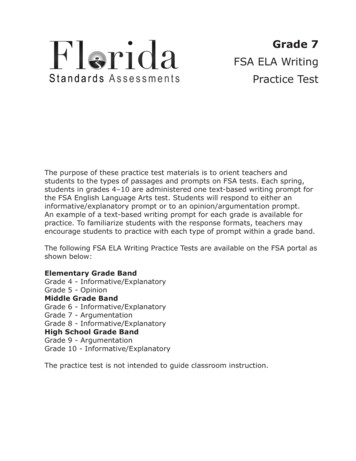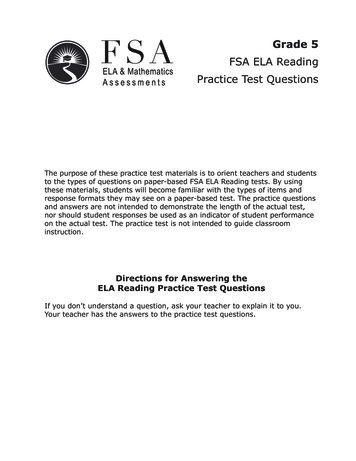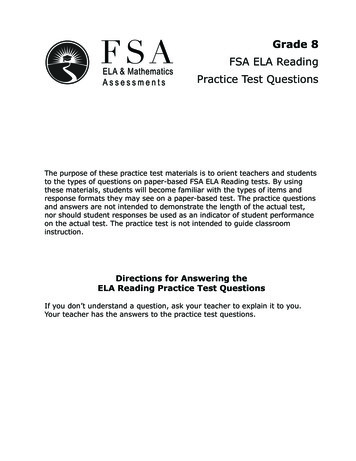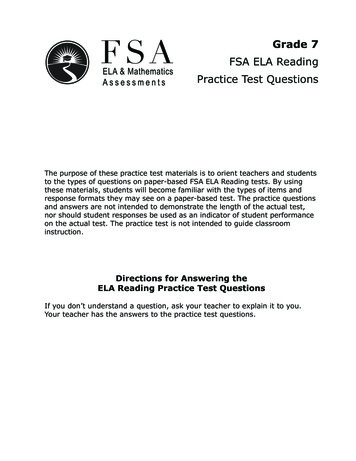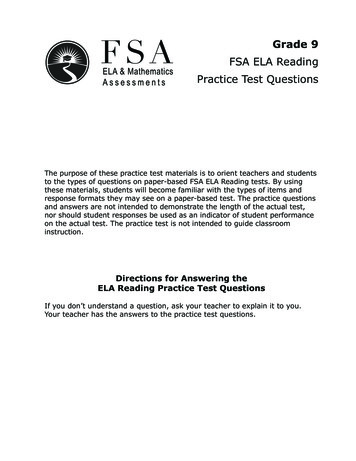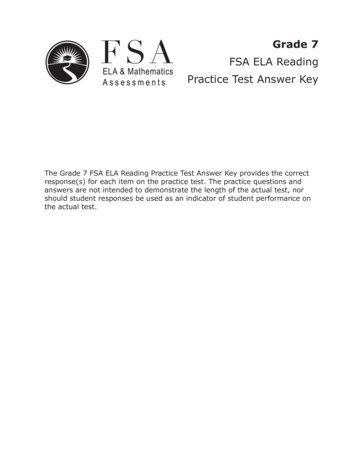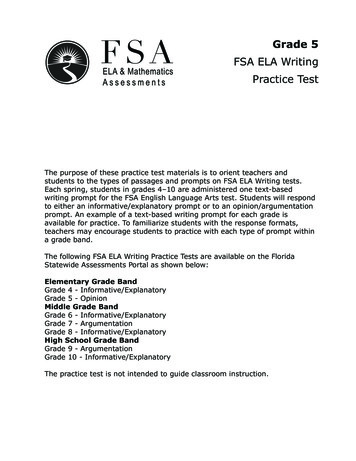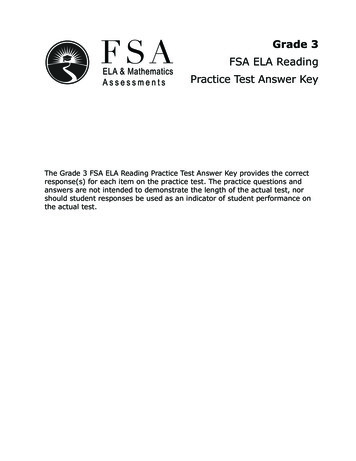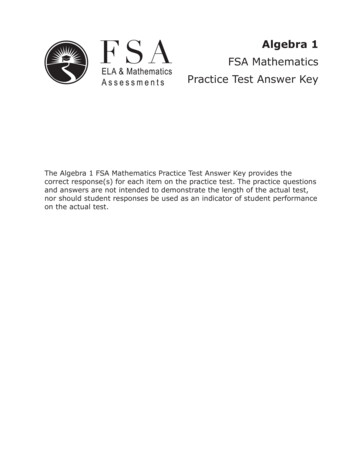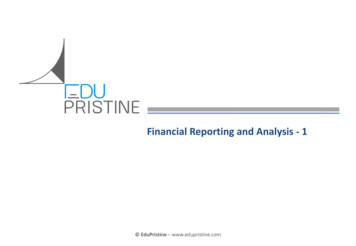
Transcription
Test Design Summary and Blueprint: English Language ArtsGrade 3 English Language Arts Standards CoverageReading, Language, and Listening ComponentReporting CategoryGenreLiteratureKey Ideas andDetailsInformationalLiteratureCraft and StructureInformationalLiteratureIntegration ofKnowledge andIdeasInformationalStandards lso assessesLAFS.3.RF.3.3 .3.5LAFS.3.RL.2.5LAFS.3.RL.2.6LAFS.2.RI.2.4Also assessesLAFS.3.RF.3.3 I.3.9LAFS.3.L1.1Percentage ofAssessment15-25%25-35%20-30%LanguageLiterature or15-25%and Editing*InformationalLAFS.3.L.1.2*Language and EditingItems may ask the student to evaluate and correct errors which focus on grammar and usage orcapitalization, punctuation, and spelling. Items should assess on-grade-level errors; however, once aLanguage Standard is introduced, grade-appropriate items may be written to assess continuedmastery of standard conventions of English.**To be assessed when administered online1 PageMay 2016
Test Design Summary and Blueprint: English Language ArtsGrade 4 English Language Arts Standards CoverageReading, Language, and Listening ComponentGenreReporting CategoryLiteratureKey Ideas andDetailsInformationalLiteratureCraft and StructureInformationalLiteratureIntegration ofKnowledge andIdeasInformationalLanguageand Editing*Literature orInformationalStandards lso o LAFS.4.L.1.2Percentage ofAssessment15-25%25-35%20-30%15-25%*Language and EditingItems may ask the student to evaluate and correct errors which focus on grammar and usage orcapitalization, punctuation, and spelling. Items should assess on-grade-level errors; however, once aLanguage Standard is introduced, grade-appropriate items may be written to assess continuedmastery of standard conventions of English.2 PageMay 2016
Test Design Summary and Blueprint: English Language ArtsGrade 4 English Language Arts Standards CoverageWriting ComponentIn Grades 4-10, the Florida Standards Assessments (FSA) English Language Arts (ELA)Writingcomponent contributes 10 raw score points to the overall FSA ELA total raw score; however, theraw score is not the most important score when considering a student’s overall performance.FSA, like other Florida statewide assessments past and present, is not scored using a percent-corrector number-correct scoring method. Students correctly answering the more-difficult items receivemore credit than students answering less-challenging items. In other words, the scoring modelinvolves both the number and the difficulty of questions a student answers correctly. As indicatedby numerous publications in the field of educational measurement, this type of scoring—patternscoring—produces a more accurate scale score for individual students than the number-correctscoring method does. Pattern scoring is used widely across this country and around the world becauseof its accuracy in measuring students’ knowledge and skills. Because each test item, including thewriting prompt, has a different effect in scoring depending on its level of challenge, no definitivepercentage of a student’s scale score is derived from the FSA ELA Writing component.3 PageReporting CategoryText Types and PurposesText-Based WritingOpinion orInformative/ExplanatoryMay 2016Standards .6
Test Design Summary and Blueprint: English Language ArtsGrade 5 English Language Arts Standards CoverageReading, Language, and Listening ComponentGenreReporting CategoryLiteratureKey Ideas andDetailsInformationalLiteratureCraft and StructureInformationalLiteratureIntegration ofKnowledge andIdeasInformationalLanguageand Editing*Literature orInformationalStandards lso assessesLAFS.5.RF.3.3 2.5LAFS.5.RL.2.6LAFS.5.RI.2.4Also assessesLAFS.5.RF.3.3 tage ofAssessment15-25%25-35%20-30%15-25%*Language and EditingItems may ask the student to evaluate and correct errors which focus on grammar and usage orcapitalization, punctuation, and spelling. Items should assess on-grade-level errors; however, once aLanguage Standard is introduced, grade-appropriate items may be written to assess continuedmastery of standard conventions of English.4 PageMay 2016
Test Design Summary and Blueprint: English Language ArtsGrade 5 English Language Arts Standards CoverageWriting ComponentIn Grades 4-10, the FSA ELA Writing component contributes 10 raw score points to the overall FSAELA total raw score; however, the raw score is not the most important score when considering astudent’s overall performance.FSA, like other Florida statewide assessments past and present, is not scored using a percent-corrector number-correct scoring method. Students correctly answering the more-difficult items receivemore credit than students answering less-challenging items. In other words, the scoring modelinvolves both the number and the difficulty of questions a student answers correctly. As indicatedby numerous publications in the field of educational measurement, this type of scoring—patternscoring—produces a more accurate scale score for individual students than the number-correctscoring method does. Pattern scoring is used widely across this country and around the world becauseof its accuracy in measuring students’ knowledge and skills. Because each test item, including thewriting prompt, has a different effect in scoring depending on its level of challenge, no definitivepercentage of a student’s scale score is derived from the FSA ELA Writing component.5 PageReporting CategoryText Types and PurposesText-Based WritingOpinion orInformative/ExplanatoryMay 2016Standards .6
Test Design Summary and Blueprint: English Language ArtsGrade 6 English Language Arts Standards CoverageReading, Language, and Listening ComponentGenreReporting CategoryLiteratureKey Ideas andDetailsInformationalLiteratureCraft and StructureInformationalLiteratureIntegration ofKnowledge andIdeasInformationalLanguage andEditing*Literature orInformationalStandards 3.8LAFS.6.RI.3.9LAFS.6.L.1.1LAFS.6.L.1.2Percentage ofAssessment15-25%25-35%20-30%15-25%*Language and EditingItems may ask the student to evaluate and correct errors which focus on grammar and usage orcapitalization, punctuation, and spelling. Items should assess on-grade-level errors; however, once aLanguage Standard is introduced, grade-appropriate items may be written to assess continuedmastery of standard conventions of English.6 PageMay 2016
Test Design Summary and Blueprint: English Language ArtsGrade 6 English Language Arts Standards CoverageWriting ComponentIn Grades 4-10, the FSA ELA Writing component contributes 10 raw score points to the overall FSAELA total raw score; however, the raw score is not the most important score when considering astudent’s overall performance.FSA, like other Florida statewide assessments past and present, is not scored using a percent-corrector number-correct scoring method. Students correctly answering the more-difficult items receivemore credit than students answering less-challenging items. In other words, the scoring modelinvolves both the number and the difficulty of questions a student answers correctly. As indicatedby numerous publications in the field of educational measurement, this type of scoring—patternscoring—produces a more accurate scale score for individual students than the number-correctscoring method does. Pattern scoring is used widely across this country and around the world becauseof its accuracy in measuring students’ knowledge and skills. Because each test item, including thewriting prompt, has a different effect in scoring depending on its level of challenge, no definitivepercentage of a student’s scale score is derived from the FSA ELA Writing component.7 PageReporting CategoryText Types and PurposesText-Based WritingArgumentation orInformative/ExplanatoryMay 2016Standards .6
Test Design Summary and Blueprint: English Language ArtsGrade 7 English Language Arts Standards CoverageReading, Language, and Listening ComponentGenreReporting CategoryLiteratureKey Ideas andDetailsInformationalLiteratureCraft and StructureInformationalLiteratureIntegration ofKnowledge andIdeasInformationalLanguageand Editing*Literature orInformationalStandards 3.8LAFS.7.RI.3.9LAFS.7.L.1.1LAFS.7.L.1.2Percentage ofAssessment15-25%25-35%20-30%15-25%*Language and EditingItems may ask the student to evaluate and correct errors which focus on grammar and usage orcapitalization, punctuation, and spelling. Items should assess on-grade-level errors; however, once aLanguage Standard is introduced, grade-appropriate items may be written to assess continuedmastery of standard conventions of English.8 PageMay 2016
Test Design Summary and Blueprint: English Language ArtsGrade 7 English Language Arts Standards CoverageWriting ComponentIn Grades 4-10, the FSA ELA Writing component contributes 10 raw score points to the overall FSAELA total raw score; however, the raw score is not the most important score when considering astudent’s overall performance.FSA, like other Florida statewide assessments past and present, is not scored using a percent-corrector number-correct scoring method. Students correctly answering the more-difficult items receivemore credit than students answering less-challenging items. In other words, the scoring modelinvolves both the number and the difficulty of questions a student answers correctly. As indicatedby numerous publications in the field of educational measurement, this type of scoring—patternscoring—produces a more accurate scale score for individual students than the number-correctscoring method does. Pattern scoring is used widely across this country and around the world becauseof its accuracy in measuring students’ knowledge and skills. Because each test item, including thewriting prompt, has a different effect in scoring depending on its level of challenge, no definitivepercentage of a student’s scale score is derived from the FSA ELA Writing component.9 PageReporting CategoryText Types and PurposesText-Based WritingArgumentation orInformative/ExplanatoryMay 2016Standards .6
Test Design Summary and Blueprint: English Language ArtsGrade 8 English Language Arts Standards CoverageReading, Language, and Listening ComponentGenreReporting CategoryLiteratureKey Ideas andDetailsInformationalLiteratureCraft and StructureInformationalLiteratureIntegration ofKnowledge andIdeasInformationalLanguageand Editing*Literature orInformationalStandards 3.8LAFS.8.RI.3.9LAFS.8.L.1.1LAFS.8.L.1.2Percentage ofAssessment15-25%25-35%20-30%15-25%*Language and EditingItems may ask the student to evaluate and correct errors which focus on grammar and usage orcapitalization, punctuation, and spelling. Items should assess on-grade-level errors; however, once aLanguage Standard is introduced, grade-appropriate items may be written to assess continuedmastery of standard conventions of English.10 P a g eMay 2016
Test Design Summary and Blueprint: English Language ArtsGrade 8 English Language Arts Standards CoverageWriting ComponentIn Grades 4-10, the FSA ELA Writing component contributes 10 raw score points to the overall FSAELA total raw score; however, the raw score is not the most important score when considering astudent’s overall performance.FSA, like other Florida statewide assessments past and present, is not scored using a percent-corrector number-correct scoring method. Students correctly answering the more-difficult items receivemore credit than students answering less-challenging items. In other words, the scoring modelinvolves both the number and the difficulty of questions a student answers correctly. As indicatedby numerous publications in the field of educational measurement, this type of scoring—patternscoring—produces a more accurate scale score for individual students than the number-correctscoring method does. Pattern scoring is used widely across this country and around the world becauseof its accuracy in measuring students’ knowledge and skills. Because each test item, including thewriting prompt, has a different effect in scoring depending on its level of challenge, no definitivepercentage of a student’s scale score is derived from the FSA ELA Writing component.Reporting CategoryText Types and PurposesStandards .W.2.5Text-Based WritingArgumentation S.8.L.3.4LAFS.8.L.3.5LAFS.8.L.3.611 P a g eMay 2016
Test Design Summary and Blueprint: English Language ArtsGrades 9-10 English Language Arts StandardsReading, Language, and Listening ComponentGenreReporting CategoryLiteratureKey Ideas andDetailsInformationalLiteratureCraft and StructureInformationalLiteratureIntegration ofKnowledge andIdeasInformationalLanguageand Editing*Literature orInformationalStandards ge ofAssessment15-25%25-35%20-30%15-25%*Language and EditingItems may ask the student to evaluate and correct errors which focus on grammar and usage orcapitalization, punctuation, and spelling. Items should assess on-grade-level errors; however, once aLanguage Standard is introduced, grade-appropriate items may be written to assess continuedmastery of standard conventions of English.Note: Because the English Language Arts Florida Standards operate in a 9-10 grade band, increasedtext complexity at grade 10 will be implemented to denote a difference between these assessments.12 P a g eMay 2016
Test Design Summary and Blueprint: English Language ArtsGrades 9-10 English Language Arts StandardsWriting ComponentIn Grades 4-10, the FSA ELA Writing component contributes 10 raw score points to the overall FSAELA total raw score; however, the raw score is not the most important score when considering astudent’s overall performance.FSA, like other Florida statewide assessments past and present, is not scored using a percent-corrector number-correct scoring method. Students correctly answering the more-difficult items receivemore credit than students answering less-challenging items. In other words, the scoring modelinvolves both the number and the difficulty of questions a student answers correctly. As indicatedby numerous publications in the field of educational measurement, this type of scoring—patternscoring—produces a more accurate scale score for individual students than the number-correctscoring method does. Pattern scoring is used widely across this country and around the world becauseof its accuracy in measuring students’ knowledge and skills. Because each test item, including thewriting prompt, has a different effect in scoring depending on its level of challenge, no definitivepercentage of a student’s scale score is derived from the FSA ELA Writing component.Reporting CategoryText Types and PurposesStandards LAFS.910.W.2.5Text-Based WritingArgumentation 613 P a g eMay 2016
Test Design Summary and Blueprint: English Language ArtsPercentage of Points by Depth of Knowledge LevelGrade3-10DOK Level 110%-20%DOK Level 260%-80%DOK Level 310%-20%CPALMS coordinated the development of common definitions using Dr. Norman Webb’s model forDepth of Knowledge. These definitions serve as the cornerstone for the rating of the Mathematicsand English Language Arts Standards available on CPALMS.Because the DOK model of content complexity was designed primarily as a framework for aligningcontent standards and assessments, it is important to distinguish between the DOK rating for a givenstandard and the possible DOK ratings for assessment items designed to address the standard. TheDOK level for an individual content standard is intended to represent the typical performance levelof cognitive complexity that a learning activity or assessment item associated with that standard mightentail. This is particularly important for assessment purposes, since 50% or more of assessment itemsassociated with a given standard should meet or exceed the DOK level of the standard.For information about content .rating,pleasevisitCPALMSatFor information about the content complexity rating for each standard, please visit CPALMS andclick the applicable content area by grade at http://www.cpalms.org/Public/search/Standard#0. Adrop-down menu for each strand and cluster includes the content complexity rating for each standard.Note: The Text-Based Writing component at grades 4-10 is a DOK level 3 task.14 P a g eMay 2016
Test Design Summary and Blueprint: English Language ArtsSessions and TimesFlorida Standards Assessments (FSA) AdministrationFSA English Language Arts (ELA)In Grades 4-10, the FSA ELA assessment includes two components,which are combined to provide a whole test FSA ELA scale score:1. A Text-Based Writing Component in which students respondto one writing task each spring. This component isadministered earlier to allow time for handscoring.2. A Reading, Language, and Listening component in whichstudents respond to texts and multimedia.FSA ELA (Writing Component Only)Grade/Subject45678910Administration Time120 minutes120 minutes120 minutes120 minutes120 minutes120 minutes120 minutesNumber ofSessions1111111ComputerBased in 2016NoNoNoNoYesYesYesFSA ELA (Reading, Language, Listening Component Only)Number ofGrade/SubjectAdministration TimeSessions*3160 minutes24160 minutes25160 minutes26170 minutes27170 minutes28170 minutes29180 minutes210180 minutes2*All sessions are administered over two days.Test LengthTest LengthFSAELAReading ComponentFSA ELA Reading ComponentApproximate Range of Number of Items by GradeGrade Band3-56-89-10Number of Items56-6058-6260-64ComputerBased in 2016NoYesYesYesYesYesYesYesPercentages of FSA ReadingText TypesGrade 70%General Notes: Approximately 6-10 items within the Reading, Language, and Listening components listed above areexperimental (field test) items and are included in the ranges above but are not included in students’ scores.The Grade 10 FSA ELA Retake follows the test design in this blueprint and is administered each spring and fall.15 P a g eMay 2016
Test Design Summary and Blueprint: English Language ArtsFlorida Standards AssessmentsTechnology-Enhanced Item DescriptionsThe Florida Standards Assessments are composed of test items that include traditional multiple-choice items, itemsthat require students to type or write a response, and technology-enhanced items (TEI). Technology-enhanced itemsare computer-delivered items that require students to interact with test content to select, construct, and/or supporttheir answers.Currently, there are eight types of TEIs that may appear on FSA English Language Arts assessments. For Grade 3assessments, which will be paper-based tests in 2015-2017, and for students with an IEP or 504 plan that specifies apaper-based accommodation, TEIs will be modified or replaced with test items aligned to the same standard/reportingcategory that can be scanned and scored electronically.The various TEI item types are described below, including the percentage of each computer-based test that will becomposed of TEIs.For samples of each of the item types described below, see the FSA Practice Tests.Percent of Computer-Based Test That Is Composed ofTechnology-Enhanced ItemsGrades 4–10 ELA*25%-50%* Grade 3 ELA tests, once computer based, will also be composed of 25%-50% TEIs.Technology-Enhanced Item Types for English Language Arts1. Editing Task Choice - The student clicks a highlighted word or phrase, which reveals adrop-down menu containing options for correcting an error as well as the highlighted word orphrase as it is shown in the sentence to indicate that no correction is needed. The student thenselects the correct word or phrase from the drop-down menu. For paper-based assessments,the item is modified so that it can be scanned and scored electronically. The student fills in acircle to indicate the correct word or phrase.2. Editing Task - The student clicks on a highlighted word or phrase that may be incorrect,which reveals a text box. The directions in the text box direct the student to replace thehighlighted word or phrase with the correct word or phrase. For paper-based assessments, thisitem type will be replaced with another item type that assesses the same standard/reportingcategory and can be scanned and scored electronically.3. Hot Text a. Selectable Hot Text - Excerpted sentences from the text are presented in this itemtype. When the student hovers over certain words, phrases, or sentences, the optionshighlight. This indicates that the text is selectable (“hot”). The student can then click onan option to select it. These items may have one or two parts. In a two-part hot textitem, Part A might ask the student to make an analysis or an inference, and Part Bmight require the student to use the text to support the answer in Part A.16 P a g eMay 2016
Test Design Summary and Blueprint: English Language ArtsIn other cases, the two parts might function independently. For paper-basedassessments, a “selectable” hot text item is modified so that it can be scanned andscored electronically. In this version, the student fills in a circle to indicate a selection.b. Drag-and-Drop Hot Text - Certain words, phrases, or sentences may be designated“draggable” in this item type. When the student hovers over these areas, the texthighlights. The student can then click on the option, hold down the mouse button, anddrag the option to a graphic organizer or other format. For paper-based assessments,drag-and-drop hot text items will be modified or replaced with another item type thatassesses the same standard/reporting category and can be scanned and scoredelectronically.4. Open Response - The student uses the keyboard to enter a response into a text field.These items can usually be answered in a sentence or two. For accommodated paper-basedassessments, this item type may be replaced with another item type that assesses the samestandard/reporting category and can be scanned and scored electronically. (Please note thatwhile the Grade 3 FSA ELA will not be administered online until 2017-18, it is possible toinclude the Open-Response item type for this paper-based assessment.)5. Multiselect - The student is directed to select a specific number of correct answers from amongthe options provided. These items are different from multiple-choice items, which allow thestudent to select only one correct answer. These items appear in the online and paper- basedassessments.6. Evidence-Based Selected Response (EBSR) - In this two-part item, the student is directed toselect the correct answers from Part A and Part B. Typically Part A is multiple-choice, whereasPart B may be either multiple-choice or multiselect. Part A often asks the student to make ananalysis or an inference, and Part B requires the student to use the text to support the answer inPart A. These items appear in the online and paper-based assessments.7. Graphic Response Item Display (GRID) - The student may select words, phrases, or imagesand use the drag-and-drop feature to place them into a graphic organizer or other format. Forpaper-based assessments, this item type may be replaced with another item type that assessesthe same standard/reporting category and can be scanned and scored electronically.8. Multimedia - Technology-enhanced content may include multimedia elements such as audioclips, slideshows, or animations. Multimedia elements may appear within passages (stimuli) ortest items. Any of the item types described above may be used to assess the multimedia content. Forpaper-based assessments, multimedia content may be modified or replaced by paper-baseditems or stimuli that assess the same reporting category. Beginning in 2015-16, listening items(audio clips) may be included in the paper-based, accommodated version of the ELA Readingassessments in Grades 4-10. (For Grade 3, listening items will be included when theassessment is administered online.)17 P a g eMay 2016
involves both the number and the difficulty of questions a student answers correctly. As indicated by numerous publications in the field of educational measurement, this type of scoring—pattern scoring—produces a more accurate scale score for individua-correct l students than the number scoring method does.
